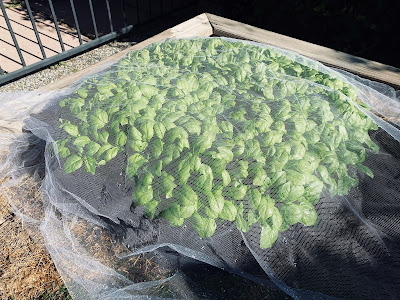When you venture outside to your 85+ degree garden in mid-afternoon, say
2ish, are you pirouetting to avoid flying Japanese beetle adults like I am?
If
your answer is no then either the hungry buggers (keeping it clean)
haven't arrived in great numbers to your landscape or you have few
plants they want to devour - a rarity since they love scores of
perennials, including grass turf, annuals, vegetables, trees and shrubs.
In our garden, they love and I mean absolutely adore, must have, gotta have and seek out the hundred+ feet of Silver Lace Vine planted over the fence next to the alley.
Very close to where the vines grow and the beetles fly around and on me are the raised beds where I spend time daily doing a variety of chores. Re-filling the bird bath, adjusting the shade cloth over the tomatoes, harvesting basil and watering the summer seeded cover crop are just a few examples.
Often I'll work for ten or more minutes at a time pulling the prostrate weeds that cleave to the granite rock chip walkways around the raised beds. Weed pulling can be tedious, but dodging flying metallic beetles is 0.00 enjoyment.

Below click on the links to read further or for a quick review about JB management. Plus there are some excellent resources you might like to bookmark.
In the meantime, here are some easy cultural (no or low expense) tips to help until they die out in early fall.
- Keep grass turf tall, as tall as you can tolerate during the 2-3 months that adult JBs are torturing our plants. Tall lawns grow larger root masses which helps the lawn mostly tolerate JB larva/grub feeding now into fall.
- Tall lawns in the heat of summer will also shade out weeds and moisture will remain longer when watered. Think about short, scalped lawns ... you always see more weeds and they dry out super quickly.
 Deter
laid eggs from developing into the next larvae stages by keeping the
lawn on the dry side during prime time JB Mama egg laying (most of the
summer). Those little eggs need moisture to grow to the larvae stage.
Reducing watering can be a bit tricky if you have tree roots growing all
through the lawn (I do).
Deter
laid eggs from developing into the next larvae stages by keeping the
lawn on the dry side during prime time JB Mama egg laying (most of the
summer). Those little eggs need moisture to grow to the larvae stage.
Reducing watering can be a bit tricky if you have tree roots growing all
through the lawn (I do).
- Please avoid keeping tree roots lacking needed moisture by cutting off all water; trees are valuable landscape plants and they are stressed enough most summers in Colorado.
- Pick off the adult beetles when they are sluggish in the early morning and late in the evening. It's immediate death when flicked into a soapy water container (I prefer Dawn dish soap). Rinse and feed to your chickens or neighbor who keeps chickens, they should comp you with some eggs for your trouble.
- To prevent plants from being chewed cover
your special plants and blooms with inexpensive bridal tulle or similar
lightweight tight mesh cloths from your locally owned garden center.
I've been using tulle for years on the basil plants grown in Smart Pots®. Covering is fairly visible, so just remove it temporarily (if needed) when you're having guests over.
Resources:
Japanese Beetle To Dos and Ponderings
My Japanese Beetle Website - tons of helpful information
A GREAT observational list of plants that Japanese Beetles like least to most for the Colorado and Intermountain region.
Report YOUR observations of feeding at this survey LINK so the list can be expanded and updated.






